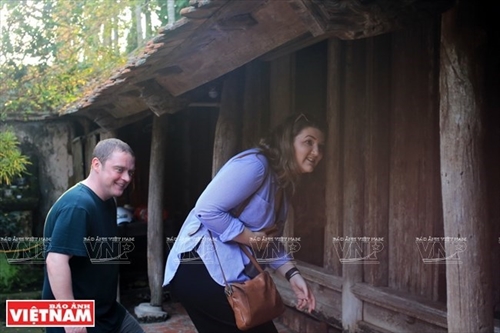A number of localities in the capital city have already engaged in the home-stay trend, including Duong Lam ancient village in Son Tay town, Dao Thuc water puppetry village in Dong Anh district, Lai Xa photography village in Hoai Duc district, and Ba Vi district.
    |
 |
|
Tourists walk into a house in Duong Lam ancient village. Photo: Vietnam Pictorial |
For example, located just 50km to the Northwest of Hanoi, Duong Lam, recognized as a national heritage area, has been a magnet for both domestic and foreign visitors for its well-preserved ancient houses and rich culture and history typical of the northern delta region.
The combination of agriculture and tourism has helped villagers find another source of income apart from their crops, all while providing tourists with a unique experience. In the past, since there were not many overnight accommodations available in Duong Lam, visitors often opted for short day trips. However, these days many local families have opened their doors to strangers for a home-stay experience. An overnight stay is exactly what people need to fully enjoy what the village has to offer. They can spend the day working with farmers and joining their daily activities.
Residents of Ba Vi district have also reaped benefits from community-based tourism.
Dinh Thi Hao has provided home-stay services at her house in the local Ba Trai commune for three years, treating customers to home grown and cooked food as well as farming experiences. She hosts between 20 and 50 guests per month, with earnings from this work up to 10 times higher than the income from her tea farm.
Meanwhile, Ba Vi commune at the foot of a mountain of the same name, where 80 percent of the population know traditional herbal medicines, has developed a series of tourism services, particularly a bathing service using traditional herbs of Dao ethnic people. Increasing popularity of the Dao bathing service has helped many families of the ethnic community escape poverty.
Hanoi’s community-based tourism, however, lacks investment in professional service supply for its sustainable growth. As a result, the revenue it brings to communities still falls short of potential. Encouraging the participation of enterprises in the model can help equipped households with better tourism knowledge and business management skills.
The capital city welcomed 5.74 million foreign visitors in 2018, up 16 percent against 2017, among 26 million tourists spending time in the city. Its key tourism markets include China, the Republic of Korea, Japan, France, the US, the UK, Germany, Thailand, Malaysia, Singapore and Canada.
The city aims to greet 6.7 million foreign visitors, out of nearly 28.6 million tourists in 2019.
Source: VNA